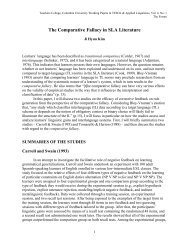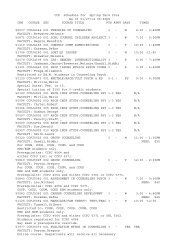UNICEF Mongolia - Teachers College Columbia University
UNICEF Mongolia - Teachers College Columbia University
UNICEF Mongolia - Teachers College Columbia University
Create successful ePaper yourself
Turn your PDF publications into a flip-book with our unique Google optimized e-Paper software.
CHAPTER 2: THE TEACHING WORKFORCE<br />
substute subjects only to fulfill the requirement of a full teaching load of 19 hours per week. Instead,<br />
they are able to teach the two or three subjects for which they have received the degree or license.<br />
Similar to other countries in the region, <strong>Mongolia</strong> embarked on a curriculum reform in 2006 that aimed<br />
at integrang several subjects into a subject area. The new curriculum enabled students to select an<br />
elecve and study that subject in greater depth aer having learned the fundamentals in a more broadly<br />
defined subject area. In 2011, the reform of 2006 was revoked and single subjects (e.g., biology, chemistry<br />
physics) were re-introduced at secondary level. A closer examinaon reveals that the integraon of<br />
subjects only took place in urban sengs. Schools in rural areas connued with teaching single subjects<br />
and, in effect, skipped the 2006 reform.<br />
Even now, preferences for single over integrated subjects are divided. At one end of the spectrum are<br />
<strong>Mongolia</strong>n experts who promote mul-subject teaching in pre-service teacher educaon for all the<br />
reasons listed above. Equally strong, however, are opponents of mul-subject training. Their argument<br />
is related to the university entrance exam (that only tests applicants in individual subjects rather than<br />
in subject areas) as well as the academic rigor required for being an effecve teacher. The discussion on<br />
depth versus breath is not unique to <strong>Mongolia</strong>. It is a long-standing discussion, and educaonal systems<br />
tend to go back and forth on the queson of how many subjects a future teacher is supposed to be able<br />
to teach. The debate in other educaonal systems, however, is over whether future teachers should<br />
be prepared to teach two or more than two subjects. None of the OECD countries prepare teachers<br />
for one subject only, because there is a high likelihood of that teacher taking on teaching hours in nonspecialized<br />
subjects, especially in smaller schools. Nevertheless, the demand for teaching one subject<br />
only is a recurrent theme in <strong>Mongolia</strong> and in Central Asia and resurfaces every few years. To some extent,<br />
the single-subject camp has mainly the teachers in the city and aimag-center schools in mind who are<br />
indeed able to teach a full teaching load in their subjects only. In soum-center schools and smaller aimagcenter<br />
schools, teachers tend to teach two or more subjects, even though they are only prepared to<br />
teach one or two subjects.<br />
2.5. TEACHER AVAILABILITY AND SHORTAGE<br />
In 2010/2011, there were 26,457 full-me teaching posions needed. 15 Of those posions, 26,358 were<br />
filled, amounng to an availability rate of 99.6 percent, or a teacher shortage of 0.4 percent, respecvely.<br />
Stascally, teacher shortage is virtually non-existent in <strong>Mongolia</strong>. However, as numerous other <strong>UNICEF</strong><br />
studies on teachers have shown, 16 stascal averages mask the extent of real teacher shortage for a<br />
variety of reasons: for example, schools cope with the shortage of qualified teachers in a given subject<br />
by filling the posion with unqualified or under-qualified substute teachers. The stascal figure on<br />
teacher shortage thus only captures the posts that, despite the coping strategies menoned above,<br />
could not be filled at the beginning of the school year. In Kyrgyzstan, for example, there are ten different<br />
coping strategies at the school level that ulmately falsely represent a lack of teacher shortage when<br />
stascs are reported. Many of these strategies, however, have a detrimental effect on the quality of<br />
teaching. The following coping strategies are very common in the CEECIS region (Central and Eastern<br />
Europe and Commonwealth of Independent States) and parcularly in the Central Asian countries<br />
(notably, Kyrgyzstan and Tajikistan):<br />
1<br />
2<br />
3<br />
4<br />
5<br />
6<br />
TEACHERS IN MONGOLIA: AN EMPIRICAL STUDY ON RECRUITMENT INTO TEACHING,<br />
PROFESSIONAL DEVELOPMENT, AND RETENTION OF TEACHERS<br />
15 Stascal Abstract (2011), Table 2.16.<br />
16 See, in parcular, <strong>UNICEF</strong> CEECIS. (2011). <strong>Teachers</strong>: A Regional Study on Recruitment, Development and Salaries of <strong>Teachers</strong> in<br />
the CEECIS Region. Geneva: <strong>UNICEF</strong> CEECIS.<br />
39


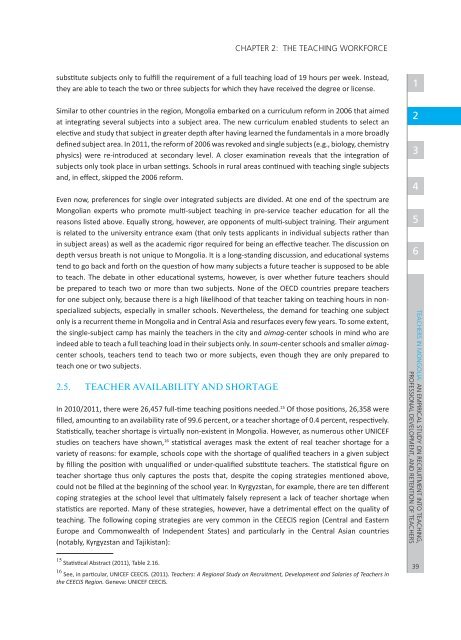
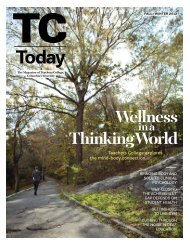

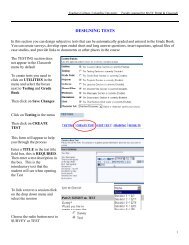

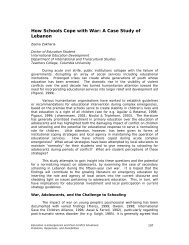


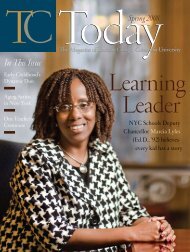



![TC Tod[...].pdf - Teachers College Columbia University](https://img.yumpu.com/27074883/1/190x252/tc-todpdf-teachers-college-columbia-university.jpg?quality=85)

